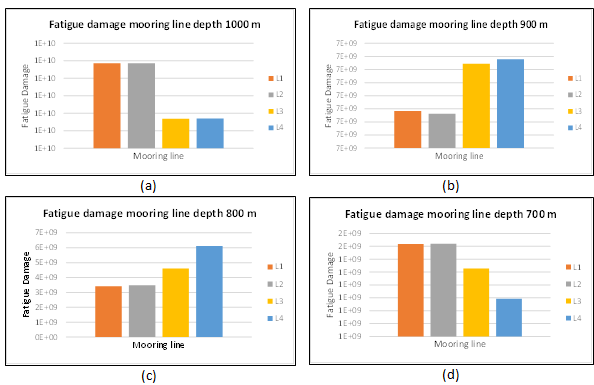Analysis of The Effect of mooring Depth & Fatigue Damage on Mooring Line FPSO Ship Azurite In The Masela Block
Main Article Content
Abstract
Downloads
Article Details

This work is licensed under a Creative Commons Attribution 4.0 International License.
References
. F. M. Assidiq, D. Paroka, M. Z. Muis, dan S. Klara, “Fatigue Analysis of Catenary Mooring System due to Harsh Environment in Head Seas", EPI International Journal of Engineering, Vol. 1, hal. 30-38, 2018.
J. Sade, “Literature Study Of The Effectiveness Of Flexible Pads As Submarine Pipeline Protection Due To Anchor Falls”, CBCER, vol. 1, no. 2 Desember, pp. 1–9, Dec. 2023.
F. Husain, “Impact and Failure of Internal Pressure of Pipe Connections C Influenced by Sea Water”, CBCER, vol. 1, no. 2 Desember, pp. 68–77, Dec. 2023.
H. Hamzah, “Study Of The Effectiveness Of Subsea Pipeline Leak Detection Methods”, CBCER, vol. 1, no. 2 Desember, pp. 45–56, Dec. 2023.
. Mahdarreza A, “Analisis Perilaku Floating LNG Pada Variasi Metocean Terhadap External Turret Mooring System Berbasis Simulasi Time Domain,” Surabaya. Tugas Akhir Jurusan Teknik Kelautan ITS 2010.
M. F. Bin Yusup, “Risk Evaluation and Damage Mitigation in Subsea Pipelines: A Literature Review of Concepts, Applications, and Challenges”, CBCER, vol. 1, no. 2 Desember, pp. 97–100, Dec. 2023.
M. Riayadh, “Literature Review on Integrity Management of Subsea Pipelines Operating Beyond Design Life”, CBCER, vol. 1, no. 2 Desember, pp. 88–92, Dec. 2023.
J. Sade, “Review of Marine Pipe Repair Methods in Indonesia”, CBCER, vol. 1, no. 2 Desember, pp. 10–17, Dec. 2023.
F. Husain, “Reliability Analysis Of Subsea Pipelines In High Wave Random Conditions”, CBCER, vol. 1, no. 2 Desember, pp. 78–83, Dec. 2023.
. N. Arifannisa, N. Syahroni, dan M. Mustedjo, “Analisis Umur Kelelahan Pada Anchor Chain Single Point Mooring 3”, Jurusan Teknik Kelautan, Fakultas Teknologi Kelautan, Institut Teknologi Sepuluh November, Hlm. 30, 2016.
. Zhang, X., Li, Y., & Li, C. "Influence of water depth on the dynamic response of FPSO mooring systems." Ocean Engineering, 166, 1-13, (2018).
T. Rachman, “Feasibility Study Of Subsea Pipeline Crossing Plan”, CBCER, vol. 1, no. 2 Desember, pp. 57–67, Dec. 2023.
H. Hamzah, “Study On The Application Of The Articulated Concrete Block Mattresses Method As Subsea Pipeline Protection”, CBCER, vol. 1, no. 2 Desember, pp. 37–44, Dec. 2023.
. Wu, Y., & Li, Y. "Fatigue damage assessment of mooring lines for deepwater FPSOs in the South China Sea." Ships and Offshore Structures, 14(2), 143-157, (2019).
. Sutarto, T. A., & Suherman, T. "Numerical study on the mooring system of FPSO in the deepwater Masela Block." Procedia Engineering, 170, 191-198, (2017).
. Peng, X., & Hong, S. "Fatigue damage analysis of mooring lines for FPSO in deepwater Masela Block." Journal of Offshore Mechanics and Arctic Engineering, 142(3), (2020).
. Zhu, L., & Zhao, Y. "Dynamic analysis of mooring system for FPSO in the Masela Block." Marine Structures, 48, 42-57, (2016).
A. Y. Kyew, “Problems and Solutions in Improving Subsea Pipeline Competency and Quality: A Comprehensive Literature Review”, CBCER, vol. 1, no. 2 Desember, pp. 93–96, Dec. 2023.
S. Rahman, “Vibration Characteristics and Reduction Analysis of the Lifting Pipe Below Sea Wave”, CBCER, vol. 1, no. 2 Desember, pp. 18–28, Dec. 2023.
N. Zin Latt, “ Literature Review of Concepts, Applications, and Challenges in Subsea Pipeline Risk and Reliability Management”, CBCER, vol. 1, no. 2 Desember, pp. 84–87, Dec. 2023.

